Legislation & Implementation: Secretary Buttigieg & USDOT's Accomplishments
(February 2021–January 2025)
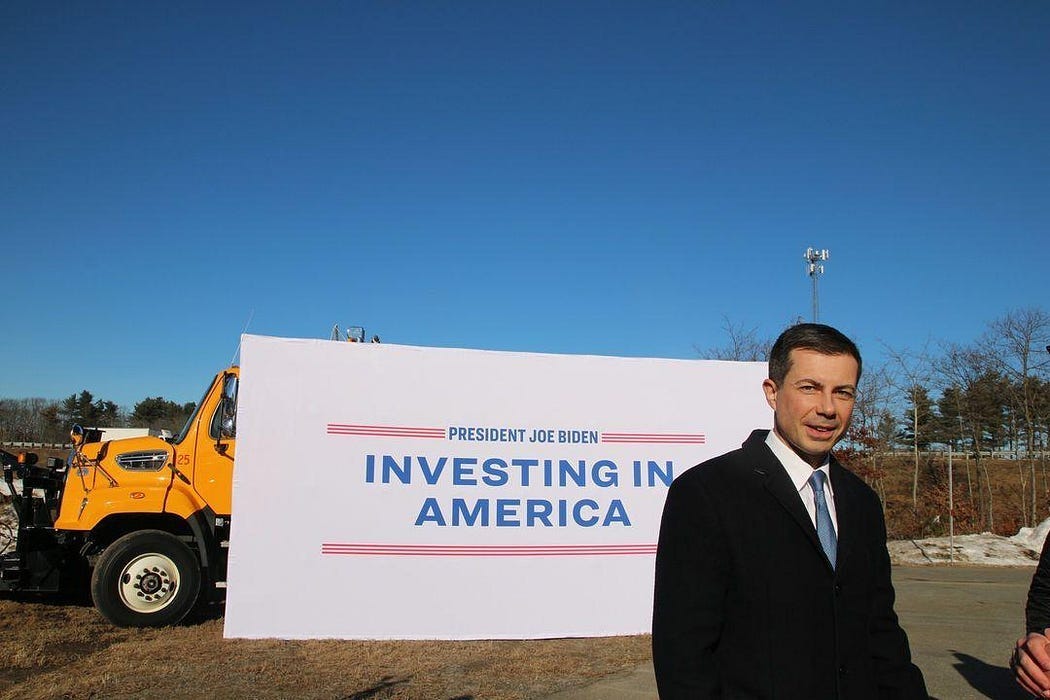
This is Part I of a series on Secretary Pete Buttigieg and USDOT's Accomplishments (February 2021 to January 2025). This part describes the Secretary and USDOT's work to design and enact the $1.2 trillion Infrastructure Investment and Jobs Act (IIJA), and it gives a high-level overview of the Secretary and USDOT's progress in implementing the IIJA and their efforts to improve the department’s processes.
To navigate to other parts of this series, follow these links: [These links will be added over time as each part gets published.]
Main Article (coming soon)
Part I: Legislation & Implementation
Part III: Economic Competitiveness (coming soon)
Part IV: Equity (coming soon)
Part V: Climate (coming soon)
Part VI: Innovation (coming soon)
Note that this series only covers Secretary Buttigieg's tenure and does not discuss policy changes or developments that occurred after he left office.
Abbreviations
IIJA — Infrastructure Investment and Jobs Act (aka, Bipartisan Infrastructure Law), which covers the five-year period of FY 2022–2026
USDOT — US Department of Transportation
FAA — Federal Aviation Administration
FHWA — Federal Highway Administration
FMCSA — Federal Motor Carrier Safety Administration
FRA — Federal Railroad Administration
FTA — Federal Transit Administration
GLS — Great Lakes St. Lawrence Seaway Development Corporation
MARAD — Maritime Administration
NHTSA — National Highway Traffic Safety Administration
OIG — Office of the Inspector General
OST — Office of the Secretary of Transportation (For simplicity, this article refers to OST as USDOT)
PHMSA — Pipeline and Hazardous Materials Safety Administration
Table of Contents
Click on the links in this section to navigate this article.
1. IIJA negotiations and enactment: Helped to design and enact the $1.2 trillion Infrastructure Investment and Jobs Act (IIJA) — supporting President Biden’s efforts to advance the legislation by conducting about 300 calls and meetings with Congress to facilitate the negotiations, doing over 125 local news hits and a total of 300 press interviews to build public support for the bill, and providing technical assistance to the White House and Congress to ensure that the legislation was designed in a way that would deliver the desired results.
2. IIJA implementation: Launched over 40 brand new USDOT programs and expanded about 30 existing programs. Announced over $400 billion for more than 62,000 transportation projects, and oversaw the completion of over 22,000 of these projects from a federal standpoint. These IIJA-funded projects included repairs and improvements to 207,000+ miles of road; 1,060+ port and waterway projects; improvements to 1,500+ airports; the production of more than 4,600 buses; more than 445 rail projects; projects to address safety issues at 1,400+ highway-rail crossings; projects to improve roadway safety in 1,600+ communities; and 695+ transportation projects across 221 Tribal Nations. Implementation of the IIJA helped to create over 920,000 US construction jobs over four years, driving up construction employment to record levels.
3. USDOT processes: Shortened timelines for complex environmental reviews. Expanded the use of categorical exclusions to streamline the permitting process. Launched a Modernizing NEPA Challenge. Tripled the pace of finalizing grant agreements compared to the previous administration. Used Phased Funding Agreements to finance large projects more quickly. Issued a final rule to eliminate unnecessary barriers to financing transportation projects through USDOT credit programs. Launched the new Project Delivery Center of Excellence and the Project Delivery Acceleration Council to help deliver projects on time, on task, and on budget. Streamlined grant application processes. Expanded the use of Emerging Projects Agreements to provide better-coordinated technical assistance to deliver large portfolios of projects. Expanded the number of Regional Infrastructure Accelerators to improve project delivery.
Legislation
1. IIJA negotiations and enactment
Summary: Helped to design and enact the $1.2 trillion Infrastructure Investment and Jobs Act (IIJA) — supporting President Biden’s efforts to advance the legislation by conducting about 300 calls and meetings with Congress to facilitate the negotiations, doing over 125 local news hits and a total of 300 press interviews to build public support for the bill, and providing technical assistance to the White House and Congress to ensure that the legislation was designed in a way that would deliver the desired results.
The $1.2 trillion Infrastructure Investment and Jobs Act (IIJA) was one of the crowning achievements of the Biden presidency — because of its historic scale and because it vindicated President Biden’s belief that, even in a hyper-partisan political climate, it was still possible to pass major legislation on a bipartisan basis. Many pundits and fellow Democrats had questioned whether the President was being naïve or old-fashioned in attempting to broker a deal with Republicans in Congress. In the end, the President proved critics wrong when 19 Republican Senators joined Democrats to pass the bill, which included:
The largest federal investment in passenger rail since Amtrak’s creation
The largest dedicated bridge funding in over 50 years
A nationwide network of fast EV charging stations
Retrofits to make older transit stations accessible to people with disabilities
By all accounts, the President worked closely with Secretary Buttigieg to achieve this victory (Image 1.1). Franklin Foer’s book The Last Politician recounts:
“As Joe Biden embarked on his negotiation, he kept Pete Buttigieg by his side. Biden said the young transportation secretary reminded him of his late son Beau. And this was his apprenticeship in dealmaking.”
Franklin Foer, The Last Politician (2023)
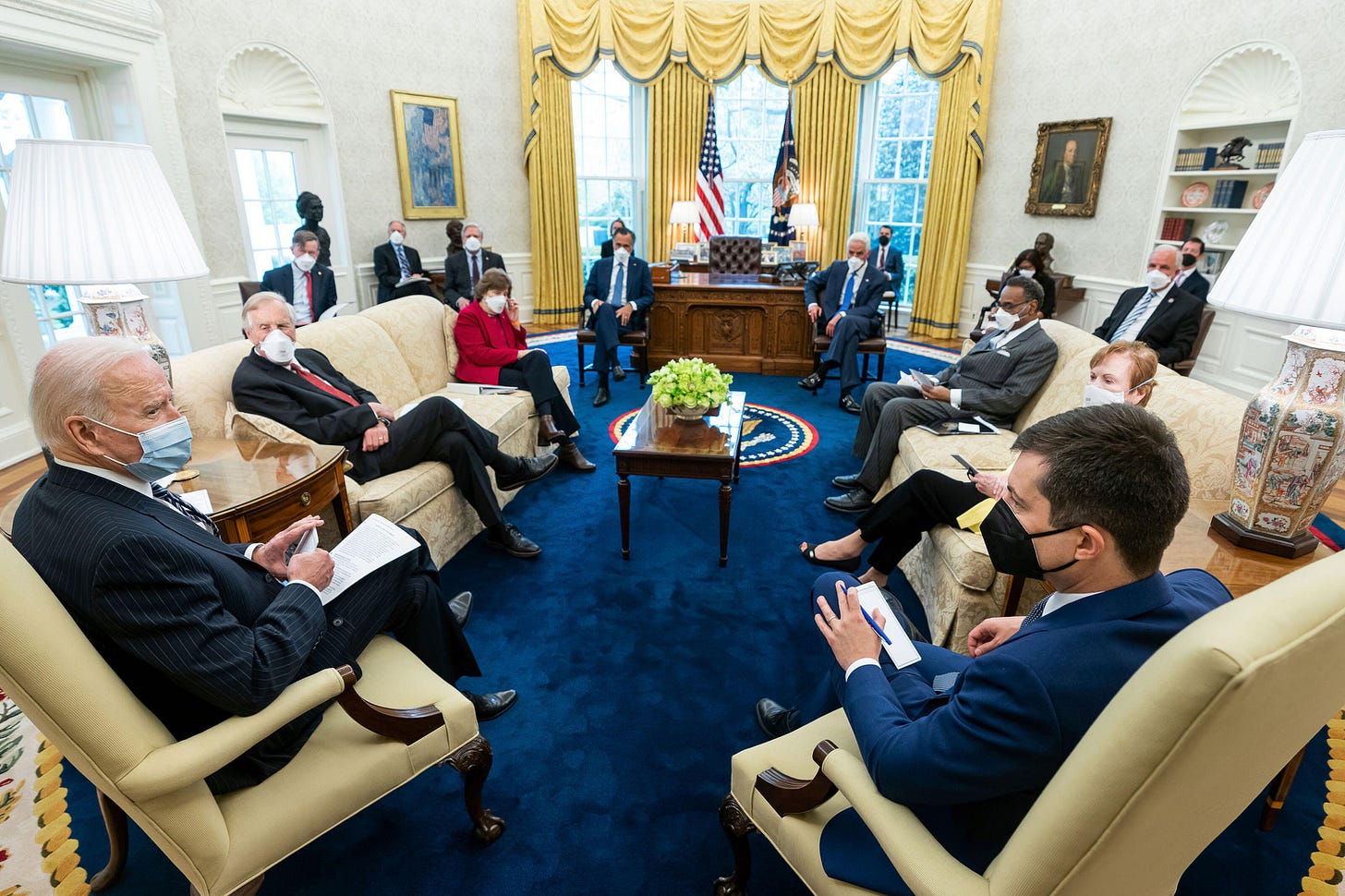
In particular, the President deployed Secretary Buttigieg’s media skills and relationships in Congress to facilitate the negotiations.
“About one year before I became Secretary of Transportation, I was running for President, and so a lot of people got to know me. And I tried to use that visibility that followed me into this job, when President Biden asked me to take this role, I tried to use that tool to help get things done, especially when we were negotiating this big infrastructure package. So because people knew who I was, I spent a lot of time arguing on television and calling up Senators and members of Congress, making the case, and was in rooms negotiating — sometimes with the President, sometimes on my own — working on how to get this done.”
Pete Buttigieg, “Civics 101” Podcast (January 7, 2025)
In April 2021, CNN reported on Secretary Buttigieg’s extensive discussions with Congressional Republicans and his media outreach during the infrastructure negotiations:
“The conversations between Buttigieg and Republican lawmakers, according to multiple members of Congress, routinely focus on the concerns that those conservatives have with the Biden plan, like how much it will cost and the view that much of it doesn’t focus on traditional infrastructure. But each lawmaker CNN spoke to said they left their conversations with the Transportation Secretary struck by how they felt listened to, something they said wasn’t often the case with other Democrats…
So far, the secretary has had conversations with Reps. Mario Diaz-Balart, a Republican who represents a district in South Florida; Rick Crawford, a senior member of the House Transportation committee who represents a solidly Republican area of Arkansas; and Rodney Davis, a top Illinois Republican on the House Highways and Transit subcommittee, according to details provided by the Department of Transportation.
Buttigieg has also had talked with Republican Sens. John Barrasso, Shelly Moore Capito and Susan Collins, as well as a bipartisan group of mayors and governors through the U.S. Conference of Mayors and National Governors Association…
The other role Buttigieg is playing is as television pitch man, regularly appearing on local and national TV to sell the bill to voters. The secretary has done local news hits for cities across the country, including Las Vegas; Pittsburgh; Dayton, Ohio; Miami; Quad Cities, Iowa; Atlanta; Milwaukee and Dallas…
‘President Biden and the White House asked Secretary Buttigieg to play a leading role in developing the President’s recovery agenda and building public support for the Rescue Plan, the Secretary’s done an admirable job in that work and in communicating it to the American people,’ a White House official who asked for anonymity to speak openly about Buttigieg’s role.”
Dan Merica, CNN, “Pitchman Pete: Buttigieg steps into the spotlight to sell Biden’s infrastructure plan” (April 9, 2021)
Rep. Brian Fitzpatrick (R-PA) recalled meeting with Secretary Buttigieg at the White House during the infrastructure negotiations, “It’s one of the reasons I respect the Secretary so much. One of his really good speeches that I was part of at the White House, he said to, ‘Make sure you understand the weight of your words, because what you say and how you say it has an impact and a ripple effect. If we’re not speaking to each other in a civilized tone, then everything else falls by the wayside.’”
Several Senators have shared their insights into the Secretary’s role. Senator Ben Cardin (D-MD) referred to Secretary Buttigieg as “the key architect of the bipartisan infrastructure bill — the person who was responsible for delivering it to Congress and, more importantly, getting it passed in Congress.” Senator Tammy Duckworth (D-IL) described how she worked with Secretary Buttigieg to create the All Stations Accessibility Program (ASAP) in the IIJA, to make older transit stations (that were built before the Americans with Disabilities Act) accessible to people with disabilities. “It was really the Secretary — I showed him the idea and he ran with it and has been a huge champion for the ASAP Act as part of the bipartisan infrastructure deal.” Senator Martin Heinrich (D-NM) recounted how he and the Secretary would meet for burgers to discuss the infrastructure negotiations, and one of those conversations focused on wildlife crossings, which eventually led them to create a Wildlife Crossing Pilot Program in the IIJA. Senator Shelley Moore Capito (R-WV), who led the first round of negotiations, said that the Secretary was in frequent communication with her, regularly following up to help work through any sticking points and facilitate a bipartisan deal.
Even for the non-transportation parts of the bill, Secretary Buttigieg served as a sounding board for members of Congress to discuss their feedback. For instance, Senator Tom Carper (D-DE) spoke to the Secretary about his initial concerns regarding the infrastructure plan’s provisions for water systems. Senator Carper said, “He is very good at anticipating questions and being able to respond to them without a lot of rhetoric or gibberish.”
Throughout the process, Secretary Buttigieg held about 300 calls and meetings with House and Senate lawmakers to advance the bill. He also conducted a media campaign to bolster public support for the legislation — the Washington Post described him as “a chief salesman for the bipartisan infrastructure plan” — doing over 125 local news hits and a total of 300 press interviews.
These included appearances on conservative media outlets, with an eye toward securing Republican votes in the Senate. For example, in a Fox News interview in April 2021 (Video 1.1), Secretary Buttigieg defended the inclusion of broadband and power grid infrastructure in the bill — which likely helped to shore up GOP Senators’ support for those provisions.
[Video 1.1] Secretary Buttigieg speaks to Fox News about the Biden administration’s infrastructure proposal in April 2021.
Behind the scenes, Secretary Buttigieg also coordinated his team at USDOT to work with the White House and Congressional offices, providing technical information and helping to design the legislation in a way that would be feasible to implement and deliver the desired results. The USDOT team won a Samuel J. Heyman Service to America Medal for their work on the legislation. Maria Lefevre represented the office of the Secretary in accepting the medal, and this is how she described the process:
“As soon as the president was elected, he started what was called the American Jobs Plan, and that plan was submitted to Congress. And what Congress does is it reaches out to executive agencies and asks for what’s called technical assistance. They ask us: ‘If we change this law, how would you implement it? Can you implement it? How fast can you get it done?’ So we spent nine months to a year helping Congress draft this bill so it would be in a way the Department of Transportation can succeed for the American people in getting over a trillion dollars out the door to local communities.”
Maria Lefevre, Executive Director, Office of the Undersecretary, USDOT
Implementation
2. IIJA implementation
Summary: Launched over 40 brand new USDOT programs and expanded about 30 existing programs. Announced over $400 billion for more than 62,000 transportation projects, and oversaw the completion of over 22,000 of these projects from a federal standpoint. These IIJA-funded projects included repairs and improvements to 207,000+ miles of road; 1,060+ port and waterway projects; improvements to 1,500+ airports; the production of more than 4,600 buses; more than 445 rail projects; projects to address safety issues at 1,400+ highway-rail crossings; projects to improve roadway safety in 1,600+ communities; and 695+ transportation projects across 221 Tribal Nations. Implementation of the IIJA helped to create over 920,000 US construction jobs over four years, driving up construction employment to record levels.
Secretary Buttigieg and USDOT were given responsibility for managing roughly half of the IIJA funding ($660 billion of the $1.2 trillion) for transportation programs over the course of five years — which was a massive expansion of the department’s grant-making responsibilities. Of these dollars, the Secretary was given the final determination on how over $200 billion in discretionary grants are awarded — which is at least five times more than any previous Transportation Secretary.
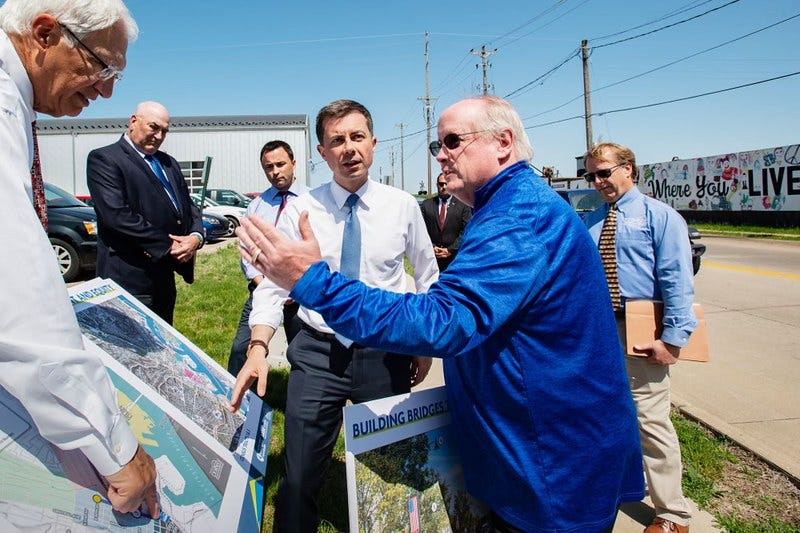
By January 2025, the Biden administration had announced over $590 billion for more than 72,000 projects funded by the IIJA. In terms of USDOT’s portion of the IIJA, over $400 billion had been announced for more than 62,000 transportation projects, of which over 22,000 of these USDOT-funded projects had been completed from a federal standpoint and $263 billion had been obligated through grant agreements. Secretary Buttigieg and USDOT had also selected nearly 5,000 discretionary grants funded by the IIJA. Unlike funding that is allocated based on a formula, these discretionary grants required USDOT staff to review many thousands of applications before the Secretary made the final selections.
These projects included:
Repairs and improvements to 207,000+ miles of road
1,060+ port and waterway projects
Improvements to 1,500+ airports
Projects to build more than 4,600 buses
More than 445 rail projects
Projects to eliminate, improve, or study 1,400+ highway-rail crossings in local communities
Projects to improve roadway safety in 1,600+ communities in all 50 states
695+ transportation projects across 221 Tribal Nations
To see more details about each of these projects, visit the archived Invest.gov website and view the interactive “Public Investments” map (Image 2.2).
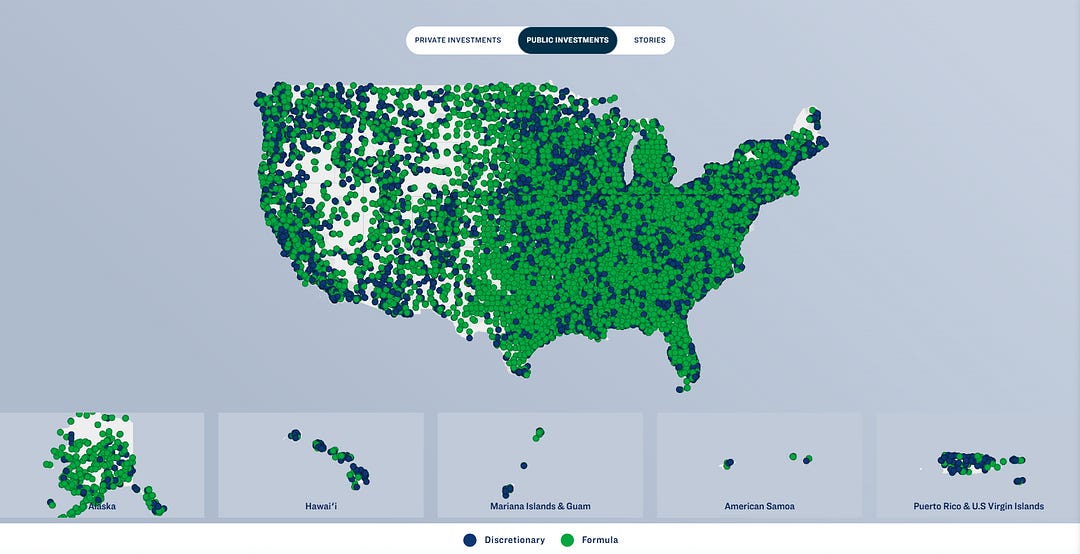
To illustrate how much USDOT’s budgetary responsibilities expanded during Secretary Buttigieg’s tenure, Chart 2.1 shows that USDOT’s funding was 85% higher in the 2023 fiscal year than in 2017.
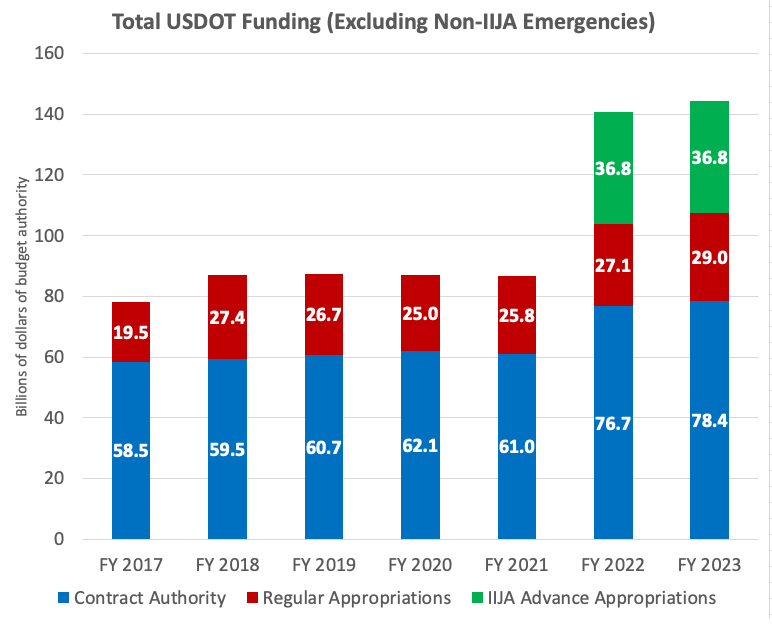
Within the first year of implementing the IIJA, USDOT launched 46 brand new programs and expanded about 30 existing programs. This involved hiring additional staff to administer these programs, designing the technical details and criteria for each program, publishing Notices of Funding Opportunity (NOFOs), holding webinars and doing public outreach to raise awareness of these NOFOs and answer applicants’ questions, reviewing grant applications, awarding the first round of grants, helping project sponsors go through the process to deliver these projects, and conducting oversight and due diligence to ensure that the funds are used properly.
Secretary Buttigieg’s experience as a small-city mayor influenced his approach to implementing the IIJA. He tried to make these programs more user-friendly and provide more helpful guidance to applicants. For example, after the city of Somerville, Massachusetts unsuccessfully applied for the first round of Safe Streets and Roads for All grants, USDOT provided feedback that helped them successfully apply for the second round of grants. “USDOT staff have been uncommonly helpful in explaining why applications weren’t successful and how they were evaluated,” said Somerville mobility director Brad Rawson.
By the time Secretary Buttigieg left office, over 22,000 projects that he and USDOT had funded through the IIJA were completed from a federal standpoint. For example, one of the first of these completed projects was the Lehigh Valley International Airport (ABE)’s terminal modernization project. Secretary Buttigieg had awarded $5 million in IIJA funding to this project through USDOT’s brand new Airport Terminal Program, and the project was completed on time and on budget, which the Secretary celebrated in July 2023 (Image 2.3).
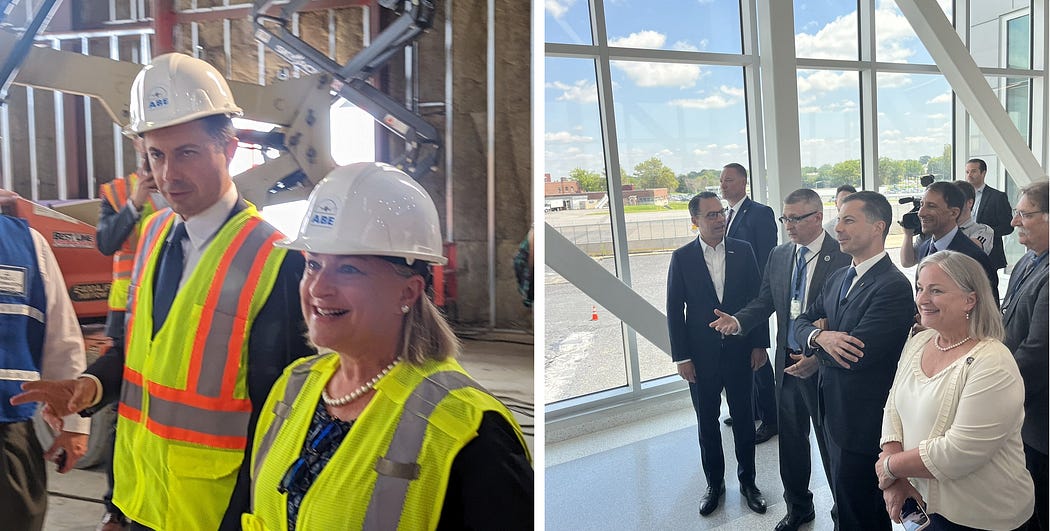
Most Americans probably do not realize that many of the recent road and bridge projects in their communities received IIJA funding. For example in October 2023, the new Second Avenue Bridge in Detroit, Michigan opened for operation and was constructed using funds from the IIJA (Video 2.1). The bridge has an innovative design that avoided the need to lower the freeway beneath it. It was constructed off-site and then moved on-site to be installed starting in July 2022. As another example, reconstruction of the Montgomery Avenue Bridge in Philadelphia was completed in September 2024 (Image 2.4). A $17 million contract for this project was awarded in 2021, and 80% of this cost was funded by the IIJA.
[Video 2.1] FHWA Administrator Shailen Bhatt joined Michigan Governor Gretchen Whitmer in Detroit to celebrate the completion of the Second Ave Bridge over I-94 — a new, safer structure that connects two important communities near Wayne State University. This project received IIJA funding and was completed in October 2023.
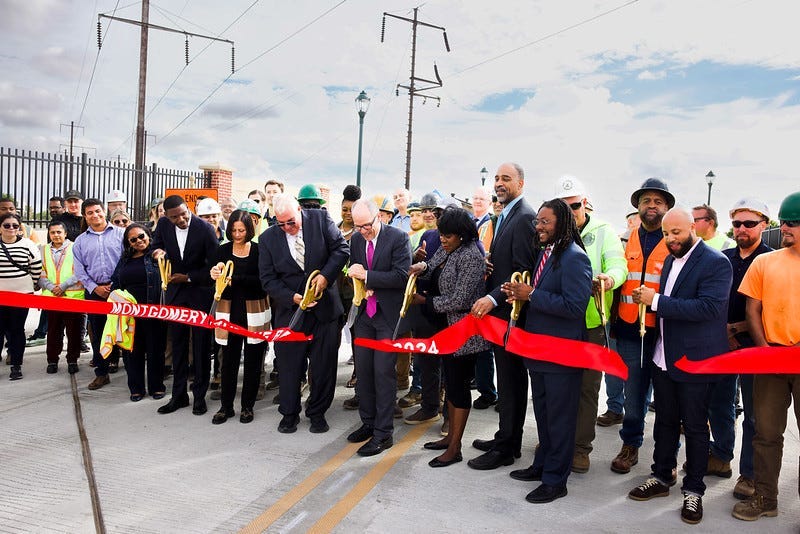
Since major infrastructure projects require years to develop, it will take time for the full benefits of the IIJA to be realized. That said, there were measurable improvements in US infrastructure during Secretary Buttigieg’s years in office. Between 2020 and 2023, the amount of bridge area in poor condition decreased by over 550,000 square meters, and the share of bridge area in poor condition fell to 4.9% in 2023, down from 5.2% in 2020. The percent of major roads in poor or mediocre condition fell to 39% in 2023, down from 43% in 2020.
Secretary Buttigieg and USDOT’s implementation of the IIJA helped to create over 920,000 US construction jobs during the Secretary’s four-year tenure, driving up construction employment to record levels — exceeding the previous peak that occurred before the Great Recession about two decades earlier (Chart 2.2).

3. USDOT processes
Summary: Shortened timelines for complex environmental reviews. Expanded the use of categorical exclusions to streamline the permitting process. Launched a Modernizing NEPA Challenge. Tripled the pace of finalizing grant agreements compared to the previous administration. Used Phased Funding Agreements to finance large projects more quickly. Issued a final rule to eliminate unnecessary barriers to financing transportation projects through USDOT credit programs. Launched the new Project Delivery Center of Excellence and the Project Delivery Acceleration Council to help deliver projects on time, on task, and on budget. Streamlined grant application processes. Expanded the use of Emerging Projects Agreements to provide better-coordinated technical assistance to deliver large portfolios of projects. Expanded the number of Regional Infrastructure Accelerators to improve project delivery.
Wherever feasible, Secretary Buttigieg sought to make USDOT’s processes more efficient and help project sponsors improve project delivery, so their projects are less vulnerable to delays and cost overruns.
Accelerating environmental reviews
Secretary Buttigieg and USDOT worked to reduce inefficiencies in the environmental review process. Under the National Environmental Policy Act (NEPA), federal agencies review projects by preparing an environmental impact statement (EIS) or an environmental assessment (EA). To help streamline this process, federal agencies can establish categorical exclusions for types of projects that do not typically have a significant environmental impact. If a categorical exclusion applies to a proposed project, the federal agency reviews whether the project involves any extraordinary circumstances that may have a significant environmental impact. If no extraordinary circumstances are present, the federal agency can permit the project without preparing an EIS or EA — which saves time and paperwork.
Expanding the use of categorical exclusions was a key strategy for Secretary Buttigieg and USDOT to speed up the permitting process. In a report to Congress in July 2024, USDOT reported that categorical exclusions account for over 99% of the department’s NEPA actions.
In June 2023, the Fiscal Responsibility Act was signed into law by President Biden. This new law allows federal agencies to adopt the categorical exclusions of other federal agencies. In September 2023, USDOT quickly used this new authority to adopt the US Department of Energy’s categorical exclusion for electric vehicle charging stations (Video 3.1). In August 2024, USDOT also adopted the US Department of Energy’s categorical exclusion to fix older, leak-prone gas pipes.
[Video 3.1] Secretary Buttigieg and Rep. Dusty Johnson (R-SD) discuss permitting reform at a Congressional hearing on September 20, 2023.
Secretary Buttigieg and USDOT also sought to streamline environmental reviews to build housing near transit. In August 2024, USDOT announced new guidance to clarify that Transportation Infrastructure Finance and Innovation Act (TIFIA) and Railroad Rehabilitation and Improvement Financing (RRIF) loans for commercial-to-residential conversion projects may be eligible for a categorical exclusion, as long as those projects do not expand the footprint of the building being converted or modify other facilities.
But for more complex projects that are not eligible for a categorical exclusion, a more thorough environmental review (an EIS or EA) is required under NEPA. Historically, these types of reviews have taken a long time to complete. Between 2010 and 2018, on average, it took just under seven years for USDOT to complete an EIS. To help speed up this process, in 2021, the IIJA created a new “major project” designation that included deadlines and schedule accountability requirements for certain projects. During Secretary Buttigieg’s tenure, 20 “major project” EISs were initiated, and on average, the timelines for these reviews was 2.5 years — less than half of the historical average.
Secretary Buttigieg and USDOT also took a variety of other measures to accelerate environmental reviews:
In January 2022, USDOT re-initiated the Transportation Rapid Response Team, an interagency forum to elevate and resolve issues on large, complex, or significant projects.
In August 2022, after months of negotiation and advocacy by Secretary Buttigieg and the Biden administration, Congress passed the Inflation Reduction Act, which authorized $100 million for USDOT to facilitate environmental review activities.
In October 2022, Secretary Buttigieg’s office released guidance to expand USDOT’s transportation liaison program, based on provisions of the FAST Act. Transportation liaisons are personnel housed in state or federal resource and regulatory agencies to facilitate the NEPA review process. State and local governments can use financial assistance from USDOT to fund liaisons dedicated to an individual project, group of projects, or program of projects.
One reason why NEPA reviews often take a long time is that the documents are dense and difficult to navigate. To improve the process, Secretary Buttigieg and USDOT launched the Modernizing NEPA Challenge and announced nine winners in December 2024. The winning projects will integrate innovative features in their NEPA documents, including easy-to-navigate tables of contents, 3D visualizations, interactive project maps, geospatial commenting, cross-agency commenting, mobile-friendly interfaces, and more.
In some cases, Secretary Buttigieg unblocked projects that had been stalled by the previous Trump administration. For example, the Gateway Hudson Tunnel Project will construct a new rail tunnel between New York and New Jersey and rehabilitate the existing tunnel. This project is long overdue as the existing tunnel is over 110 years old and has been deteriorating for decades, exacerbated by damage from Superstorm Sandy in 2012. Despite this urgency, the Trump administration opposed the project and did not finalize the EIS after the draft was submitted to USDOT in February 2018. Once the Trump administration ended, the project could finally move forward again. Just three months after Secretary Buttigieg took office, FRA and FTA issued the final EIS and Record of Decision for the Gateway Hudson Tunnel Project in May 2021, about five years after the review process was initiated.
Streamlining the grant application process
To reduce the burden on grant applicants, USDOT combined the INFRA, Mega, and RURAL programs into one Notice of Funding Opportunity (NOFO), so applicants can apply for any or all of those programs by submitting one application. The Reconnecting Communities Pilot Program and the Neighborhood Access and Equity Program were also combined into one NOFO.
Phased Funding Agreements
One common barrier to delivering large transportation projects is that it often takes a long time to secure sufficient financing — which might require a project sponsor to apply for several different federal grants over the course of multiple years. To help overcome this barrier, the IIJA created a new tool called a Phased Funding Agreement, which allowed Secretary Buttigieg to enter into a multiyear funding agreement for prioritized projects.
For example in December 2023, Secretary Buttigieg announced $3 billion in Federal-State Partnership Grants for the Brightline West high-speed rail project. The large size of this grant was made possible through the use of a Phased Funding Agreement. Under this agreement, the Brightline West project received about $2 billion from FY22–23 funds, and FRA made a contingent promise to provide the remaining $1 billion from FY24–26 funds. This way, the project sponsor secured the full $3 billion upfront, rather than needing to wait and submit another application for the FY24–26 funds.
Grant agreements and pre-award authority
After the Secretary announces a grant award, the next step is for USDOT and the project sponsor to negotiate and sign a grant agreement, which is a legal contract that sets the terms and procedures for disbursing the funds. Secretary Buttigieg often expressed frustration that it typically has taken a year or more to finalize a grant agreement. And with the passage of the IIJA, there was a massive increase in USDOT’s workload for negotiating and managing these agreements for over 60,000 projects. So the Secretary pushed to accelerate the process and found that even simple measures like pre-populating forms proved to be helpful (Video 3.2).
By the end of his tenure, Secretary Buttigieg reported that USDOT had tripled the pace of getting grant agreements done compared to the previous administration. As of the end of January 2025, USDOT had obligated $263 billion in IIJA funding through grant agreements, accounting for 65% of announced funding awards.
[Video 3.2] Speaking to The Atlantic on September 19, 2024, Secretary Pete Buttigieg discusses USDOT’s efforts to speed up project delivery by finalizing grant agreements more quickly and encouraging the use of pre-award authority.
Typically, a project cannot begin incurring costs until the grant agreement is finalized, which may take a year or more and can cause costly delays. To help projects move forward more quickly, Secretary Buttigieg and USDOT sought to make it easier to use pre-award authority, which allows project sponsors to begin incurring certain allowable costs before a grant agreement is finalized —and then these costs are eligible to be reimbursed after the grant agreement is signed. For example, after Secretary Buttigieg announced a $3 billion grant for the Brightline West high-speed rail project in December 2023, it took about nine months for FRA and the Nevada Department of Transportation to finalize the grant agreement in September 2024. While this grant agreement was being developed, the project continued to move forward using pre-award authority to conduct pre-construction work.
In May 2024, FTA expanded pre-award authority for Small Starts projects. “In addition to pre-award authority for vehicle purchases, FTA now also will extend pre-award authority for any remaining engineering and design, demolition, and procurement of long lead items for which market conditions play a significant role in the acquisition price. The long lead items include, but are not limited to, procurement of rails, ties, and other specialized equipment, and commodities.”
In March 2023, FRA published its policy to allow pre-award authority for certain intercity rail projects in the Northeast Corridor, and it published FAQs for this policy in September 2023. In October 2024, FRA proposed to create a standardized form to streamline the process for project sponsors to request pre-award authority.
Removing barriers to financing transportation projects
The IIJA enabled USDOT to modify the TIFIA and RRIF credit programs to remove barriers to accessing these loans. With authority from the IIJA, in May 2024, USDOT issued a final rule that made significant changes to these programs. The rule took effect on June 24, 2024. The law firm Ballard Spahr published this helpful summary about the significance of this rule:
“The final rule expands RRIF and TIFIA accessibility and utility for a wider range of projects. The new interest rate setting provision will provide for longer-term TIFIA and RRIF obligations to be adjusted on a yearly basis beyond the current 30-to-40 year timetable, providing higher value to longer-term projects. The interest rate spread provisions remove a barrier to utilization of RRIF by no longer requiring borrowers to repay credit risk premiums. The change in statutory requirements regarding TIFIA eligibility expands the scope of the TIFIA program to projects that are not included in the applicable state’s transportation plan.”
Ballard Spahr, “USDOT Implements Infrastructure Act’s Final Rules for RRIF and TIFIA Programs,” (May 30, 2024)
The law firm Nixon Peabody noted that eliminating the repayment of credit risk premiums on RRIF loans was especially significant, because borrowers were previously required to pay the premium upfront before receiving the loan. Eliminating that upfront cost made RRIF loans much more attractive.
Regional Infrastructure Accelerators Program
In general, Secretary Buttigieg sought to expand USDOT’s technical assistance services to help project sponsors follow best practices to go through the planning, financing, and permitting process more quickly and smoothly.
To offer more technical assistance, USDOT expanded the Regional Infrastructure Accelerators Program. To some extent, Regional Infrastructure Accelerators (RIAs) serve as field offices for USDOT’s Build America Bureau, serving particular regions. This program was originally authorized by the Fixing America’s Surface Transportation (FAST) Act enacted in December 2015, and the first NOFO for this program was issued in December 2020 at the end of the Trump administration. The first 10 RIAs were selected by Secretary Buttigieg in 2021 and 2022, and then in 2023, the Secretary expanded the program to include 24 RIAs. As an example of how this program supports the planning of regional projects, the Fresno Council of Governments RIA advanced the TradePort California Project by funding an investment proposal to the state of California for $49.7 million for site acquisition, energy fueling and charging, truck parking, logistics asset development, and solar power generation.
Emerging Projects Agreements
To more efficiently coordinate the planning and financing of large portfolios of regional projects, USDOT has been using a relatively new organizing tool called Emerging Projects Agreements. This concept was first developed in 2016 under the Obama administration, and Secretary Buttigieg revived and expanded its use. An Emerging Projects Agreement is a strategic partnership between a project sponsor (typically a local government) and USDOT’s Build America Bureau, which oversees Private Activity Bonds (PABs) and administers the TIFIA and RRIF low-interest financing programs. Under these agreements, USDOT provides centralized technical support to help the project sponsor finance and deliver a portfolio of multiple projects — as opposed to treating each project as a separate silo.
During Secretary Buttigieg’s tenure, USDOT formed Emerging Projects Agreements with Kansas City, Missouri; Austin, Texas; and California’s State Transportation Administration (CalSTA). For example, Kansas City’s agreement covers a $15 billion portfolio of proposed projects, including a 21-mile rail line to connect the airport to the downtown area, an expansion of streetcar service, multiple projects to reconnect disadvantaged communities that were divided by past highway construction, bridge repairs and replacements, and the city’s Vision Zero projects to make roads safer.
Project Delivery Center of Excellence
In July 2023, USDOT launched the Project Delivery Center of Excellence at the Volpe Center to help project sponsors deliver projects on time, on task, and on budget. As part of the launch, Secretary Buttigieg held a webinar with Oxford Professor Bent Flyvbjerg, author of How Big Things Get Done and Megaprojects and Risk, to discuss insights that are relevant to the new center’s work — which includes:
Serving as a central place to disseminate and share best practices;
Streamlining construction contracts by providing templates and model language; and
Studying the root causes of construction change orders (i.e., changes to a project that were not in the original contract and can cause cost overruns) and identifying best practices to prevent change orders.
Since its launch, the Center has published a Project Delivery Toolbox that offers guidance on each phase of the project management, financing, environmental review, and construction process. In late 2023, the Center also conducted an eight-part thought leadership series that focused on improving project delivery for IIJA-funded projects. For example, this series highlighted how “using best value or alternative delivery methods — such as design-build, progressive design-build, and construction manager/general contractor — can help streamline project timelines, minimize delays, reduce costs, and accelerate project completion, enabling transportation infrastructure to meet and keep pace with evolving community needs.”
When speaking to the Council on Foreign Relations in November 2023, Secretary Buttigieg discussed some factors that can cause sluggish project timelines, and he mentioned USDOT’s new Project Delivery Center of Excellence as a step toward tackling that challenge (Video 3.3).
[Video 3.3] Speaking to the Council on Foreign Relations on November 28, 2023, Secretary Buttigieg responds to a question about why US transportation projects tend to cost more than in other countries.
Project Delivery Acceleration Council
A month before leaving office, in December 2024, Secretary Buttigieg formed a Project Delivery Acceleration Council at USDOT. The purpose of the Council is to ensure that all offices across the department are sharing information and working together seamlessly to speed up the delivery of USDOT-funded projects. This includes developing metrics and targets to track and evaluate project delivery performance, as well as identifying challenges or opportunities to improve the administration of NOFOs, grant agreements, environmental reviews, and other processes. Assuming this Council continues into the next administration, it will help continue progress toward faster project delivery.
